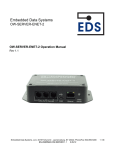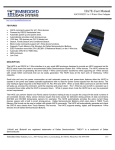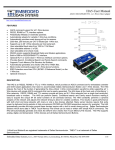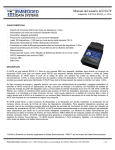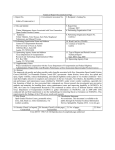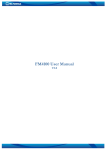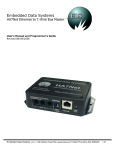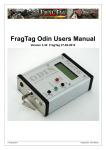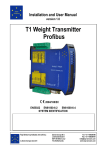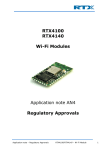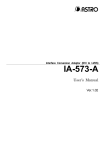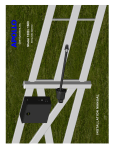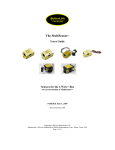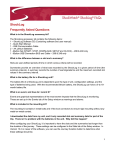Download User Manual - Embedded Data Systems
Transcript
EDS-0090 OW-IO-DIO8 1-Wire Interface for 8 Discrete I/O http://www.EmbeddedDataSystems.com FEATURES • • • • • • • • • • • • • Has 8 connections; each may be an input and/or output. Inputs accept up to 27 volts DC*. Outputs are open drain and can sink up to 1 amp. Connections have independently controlled pull-down resistors. ® Compatible with all EDS and Maxim 1-Wire bus masters. Uses 1-Wire communication protocol. Input channels 1 and 2 report; pulse counts, activity latch & input states. Input channels 3 to 8 report; activity latch and input states. Optional Relay may be controlled independently or by alarm status. LED may be controlled independently or by alarm status. Support Conditional Search with user-selectable conditions. Automatic unique 64-Bit device addressing. Applications include thermostatic controls, industrial systems, flow meters, consumer products, or any system in which discrete control or monitoring is necessary. DESCRIPTION The Octal Discrete I/O device offers an innovative way to monitor and control up to 8 digital channels. Each of the 8 points may be an input or an output under program control. Additionally, each channel has an activity latch, a programmable pulled-own resistor and programmable high / low alarms. Input channels 1 & 2 also include 32 bit pulse counters. The Octal Discrete I/O also includes an LED, conditional search support and an optional latching relay. These features combine to offer a flexible system for monitoring and controlling numerous data points throughout a 1Wire network in an efficient manner. The conditional search support allows a host adapter to quickly identify whether any alarm parameters have been met; and the LED and optional latching relay can be configured to behave in a variety of ways: • • • Activate when an alarm becomes active and automatically deactivate when the alarm is cleared Activate when within alarm parameters and deactivate when within normal range Independently controlled The nearly instant automated responses made by the LED and optional relay allows appropriate reactions (activate fan/alarm siren/etc.) to occur before the monitoring application is even aware of an alarm. The Octal Discrete I/O has been designed with the intention of simplifying the reading and control process; therefore any general-purpose 1-Wire host adapters is capable of reading the discrete points. * The maximum input voltage may be extended to 48 Volts by disabling the pull-down resistor. Embedded Data Systems, LLC.; 2019 Fortune Drive; Lawrenceburg, KY 40342; Phone/Fax 502-859-5490 EN-USERMAN OW-IO-DIO8 V1.0 02.20.13 1-9 MEMORY MAP The memory consists of three 32 byte pages. Page 0 is the tag, page 1 and 2 contain operational data. Pages 0, 1 and the first half of page 2 are read only, while the second half of page 2 can be written. Page 0 Addr 0 - 27 28 29 30 31 Page 1 Addr 32 33 34 35 36 37 38 39 40 41 42 43 44 45 46 47 48 49 50 51 52 53 54 55 56 57 58 59 60 61 62 63 Page 2 Addr 64 65 66 67 68 69 b7 3 2 3 2 7 2 15 2 b6 2 2 2 2 6 2 14 2 b7 b5 1 2 1 2 5 2 13 2 b0 0 2 0 2 0 2 8 2 b2 2 12 2 5 5 5 5 2 11 2 4 4 4 4 2 10 2 3 3 3 3 b1 1 2 9 2 2 2 2 2 LED b0 0 2 8 2 1 1 1 1 Rly low 4 low 8 7 2 15 2 23 2 31 2 7 2 15 2 23 2 31 2 7 2 15 2 23 2 31 2 high 4 high 8 6 2 14 2 22 2 30 2 6 2 14 2 22 2 30 2 6 2 14 2 22 2 30 2 low 3 low 7 5 2 13 2 21 2 29 2 5 2 13 2 21 2 29 2 5 2 13 2 21 2 29 2 high 3 high 7 4 2 12 2 20 2 28 2 4 2 12 2 20 2 28 2 4 2 12 2 20 2 28 2 low 2 low 6 3 2 11 2 19 2 27 2 3 2 11 2 19 2 27 2 3 2 11 2 19 2 27 2 high 2 high 6 2 2 10 2 18 2 26 2 2 2 10 2 18 2 26 2 2 2 10 2 18 2 26 2 low 1 low 5 1 2 9 2 17 2 25 2 1 2 9 2 17 2 25 2 1 2 9 2 17 2 25 2 high 1 high 5 0 2 8 2 16 2 24 2 0 2 8 2 16 2 24 2 0 2 8 2 16 2 24 2 b7 b6 b5 4 b4 b3 b1 1 2 1 2 1 2 9 2 2 13 2 6 6 6 6 5 b4 b2 2 2 2 2 2 2 10 2 2 14 2 7 7 7 7 6 b5 b3 3 2 3 2 3 2 11 2 2 15 2 8 8 8 8 7 b6 b4 0 2 0 2 4 2 12 2 3 b3 2 b2 b1 Tag Version, low Version, high ID, low ID, high R R R R R ID, low ID, high Input states Activity latch states Output states Pull-down states Relay / LED State Reserved Reserved Reserved Alarm states Reserved Reserved Reserved Reserved Reserved Reserved Reserved Reserved R R R R R R R R R R R R R R R R R R R R R R R R R R R R R R R R Reserved Reserved Reserved Reserved Reserved Reserved R R R R R R Seconds counter Seconds counter Seconds counter Seconds counter Pulse counter 1 Pulse counter 2 b0 Embedded Data Systems, LLC.; 2019 Fortune Drive; Lawrenceburg, KY 40342; Phone/Fax 502-859-5490 EN-USERMAN OW-IO-DIO8 V1.0 02.20.13 2-9 70 71 72 73 74 75 76 77 78 79 80 81 82 83 84 85 86 87 88 89 90 91 92 93 94 95 low 4 low 8 high 4 high 8 low 3 low 7 high 3 high 7 low 2 low 6 high 2 high 6 low 1 low 5 high 1 high 5 8 7 6 5 4 3 2 2 1 1 low 4 low 8 high 4 high 8 low 3 low 7 high 3 high 7 low 2 low 6 high 2 high 6 low 1 low 5 high 1 high 5 8 8 7 7 6 6 5 5 4 4 3 3 2 2 1 1 L1 L0 R1 LED R0 Rly Reserved Reserved Reserved Reserved Reserved Reserved Reserved Reserved Reserved Reserved Conditional search Reserved Reserved Pulse counter reset Activity latch reset Reserved Reserved Alarm values Reserved Pull-down values (30) Output values Reserved Relay / LED Function Relay / LED value R R R R R R R R R R RW RW RW RW RW RW RW RW RW RW RW RW RW RW RW RW * If the relay is not populated the bits pertaining to the Relay Function may be ignored. INPUTS The current input states are read using the Input states byte, location 34. The input state is de-bounced at 10ms, making it useful to read contact closures. An activity latch (location 35) is maintained for each input. Any change in state (high-to-low or low-to-high) causes the activity latch to be set. The activity latch states are detected by both the input state logic (de-bounced at 10ms) and the pulse counter logic (channels 1 & 2 only). Since the pulse counter logic is falling edge triggered only, a state change that is faster than what can be detected by the input state logic will only trigger the activity latch if it contains a falling edge. Any or all of the bits in the activity latch can be cleared, by writing to the Activity Latch Reset byte (location 85) with the desired bit or bits set; multiple bits can be cleared at the same time. The activity latch reset byte always reads zero. Input channels 1 & 2 include 32 bit pulse counters. The pulse is counted on the falling edge. Any counter can be reset, by writing to the appropriate bit stored at pulse counter reset location (location 84). Each counter can handle up to 40K per second. Contact the factory for applications that require faster pulse counting. OUTPUTS The outputs are open collector MOSFET transistors with unidirectional overvoltage TVS diodes (48 volt). When the output state is high, the transistor is off. If there is pull-up current (such as a pull-up resistor), a voltmeter will read high. When the output state is low, the transistor is on and the output will read low. Note that if there is no pull-up current, the output may be off, but a voltmeter will not read high. Output State byte, location 36, reflects the current output states, and is read only. Outputs are set, by writing to the Output Value byte, location 92. The Input State, Activity Latch and Pulse Counter values will continue to update if a point is used as an output, so long as the voltage at the pin rises above the one threshold when the output transistor is turned off (i.e. there is a pull-up resistor). Embedded Data Systems, LLC.; 2019 Fortune Drive; Lawrenceburg, KY 40342; Phone/Fax 502-859-5490 EN-USERMAN OW-IO-DIO8 V1.0 02.20.13 3-9 PULL-DOWNS Each pin has a 1.5k Ohm, 0.5 Watt pull-down resistor which may be turned on using the Pull-down value byte (location 91). Setting a bit high turns off the pull-down, low turns it on. This resistor may be used to read contact closures, simply connect one end of the contact to a voltage (i.e. 5, 12 or 25 volts) and the other end to the input pin. When the contact is closed, the input will read a 1, when it is open the pull-down resistor will cause it to read 0. The pull-down resistor should be turned off when a channel is being used as an output. ALARMS Alarms are based on the Input State; they are calculated every time a reading is made from the inputs. If the reading is above the high alarm value, the corresponding high alarm bit is set, and if the reading is below the low alarm value, the low alarm bit is set. Alarm bits can only be cleared by sending the clear alarms command (0x33), which clears all alarm bits. No provision is made to clear individually selected alarm bits. CONDITIONAL SEARCH The device will respond to the conditional search command from a master if any or all of the conditional search bits are set. The conditional search bits are set when an alarm becomes active and are cleared only under program control, by writing to the appropriate bit(s) at location 80 and 81. SECONDS COUNTER The 32 bit counter (bytes 44 to 47) is set to zero at power up and increments approximately once per second. RELAY AND LED The relay and LED may operate in any of the following modes: Bit L1 (LED) or R1 (Relay) 0 0 1 1 Mode (0) On with any alarm, off if no alarms active (1) On with any alarm, off when clear alarms command received (2) On and Off under command using State bit (address 95) (3) Always off Bit L0 (LED) or R0 (Relay) 0 1 0 1 The relay is a latching relay; it retains its state when power is lost. The states of the relay and LED are stored in non-volatile memory and are restored at power-up. Since the relay is latching, its state remains the same, even when power is removed. PROGRAMMABLE VALUES Programmable values are stored in non-volatile memory. Alarm High Alarm Low Pulse Counter Reset* Activity Latch Reset* Pull-down Value Output Value Factory Default 1 0 0 0 1 1 Minimum Value 0 0 0 0 0 0 Maximum Value 1 1 1 1 1 1 *These values always read zero. Writing a 1 to the appropriate bit causes the reset to occur, writing a 0 has no effect. 1-WIRE COMMUNICATIONS The device communicates via 1-wire at standard speed only; overdrive is not supported. All memory pages are 32 bytes, CRC16 and a 32 byte scratchpad is used to write data to the device. ROM Commands After the bus master has detected a presence pulse, it can issue a ROM command. These commands operate on the unique 64-bit ROM codes of each slave device and allow the master to single out a specific device if many are present on the 1-Wire bus. These commands also allow the master to determine how many and what types of devices are present on the bus or if any device has experienced an alarm condition. There are five ROM Embedded Data Systems, LLC.; 2019 Fortune Drive; Lawrenceburg, KY 40342; Phone/Fax 502-859-5490 EN-USERMAN OW-IO-DIO8 V1.0 02.20.13 4-9 commands, and each command is 8 bits long. The ROM commands function the same as on other 1-wire devices. The master device must issue an appropriate ROM command before issuing a function command. Alarm Search ROM – 0xEC The operation of this command is identical to the operation of the Search ROM command except that only slaves with a set alarm flag (bytes 80 and 81) will respond. This command allows the master device to determine if any EDS Discrete I/O device is in an alarm. After every Alarm Search cycle (i.e., Alarm Search command followed by data exchange), the bus master must return to Step 1 (Initialization) in the transaction sequence. See the Operation—Alarm Signaling section for an explanation of alarm flag operation. Search ROM – 0xF0 When a system is initially powered up, the master must identify the ROM codes of all slave devices on the bus, which allows the master to determine the number of slaves and their device types. The master learns the ROM codes through a process of elimination that requires the master to perform a Search ROM cycle (i.e., Search ROM command followed by data exchange) as many times as necessary to identify all of the slave devices. If there is only one slave on the bus, the simpler Read ROM command (see below) can be used in place of the Search ROM process. For a detailed explanation of the Search ROM procedure, refer to the iButton® Book of Standards at www.maxim-ic.com/ibuttonbook. After every Search ROM cycle, the bus master must return to Step 1 (Initialization) in the transaction sequence. Match ROM – 0x55 The match ROM command followed by a 64-bit ROM code sequence allows the bus master to address a specific slave device on a multi-drop or single-drop bus. Only the slave that exactly matches the 64-bit ROM code sequence will respond to the function command issued by the master; all other slaves on the bus will wait for a reset pulse. Skip ROM – 0xCC The master can use this command to address all devices on the bus simultaneously without sending out any ROM code information. For example, the master can clear all alarming EDS Environmental sensors on the bus or perform simultaneous temperature conversions by issuing a Skip ROM command followed by a Clear alarms [0x33] command. Note that the Read Scratchpad [0xAA] command can follow the Skip ROM command only if there is a single slave device on the bus. In this case, time is saved, by allowing the master to read from the slave without sending the device’s 64-bit ROM code. A Skip ROM command followed by a Read Scratchpad command will cause a data collision on the bus if there is more than one slave since multiple devices will attempt to transmit data simultaneously. Read ROM – 0x33 This command can only be used when there is one slave on the bus. It allows the bus master to read the slave’s 64-bit ROM code without using the Search ROM procedure. If this command is used when there is more than one slave present on the bus, a data collision will occur when all the slaves attempt to respond at the same time. Memory / Control Commands Write scratchpad – 0x0F Read scratchpad – 0xAA Copy scratchpad – 0x55 Read memory no CRC – 0xF0 Read memory with CRC – 0xA5 Clear alarms – 0x33 Write Scratchpad – 0x0F After issuing the Write Scratchpad command, the master must first provide the 2-byte target address, followed by the data to be written to the scratchpad. The data will be written to the scratchpad starting at the byte offset (T4:T0). The ending offset (E4:E0) will be the byte offset at which the master stops writing data. Only full data bytes are accepted. If the last data byte is incomplete, its content will be ignored. When executing the Write Scratchpad command, the CRC generator inside the device calculates a CRC of the entire data stream, starting at the command code and ending at the last data byte sent by the master. This CRC is generated using the CRC16 polynomial by first clearing the CRC generator and then shifting in the command code Embedded Data Systems, LLC.; 2019 Fortune Drive; Lawrenceburg, KY 40342; Phone/Fax 502-859-5490 EN-USERMAN OW-IO-DIO8 V1.0 02.20.13 5-9 (0Fh) of the Write Scratchpad command, the Target Addresses TA1 and TA2 as supplied by the master and all the data bytes. The master may end the Write Scratchpad command at any time. However, if the ending offset is 11111b, the master may send 16 read time slots and will receive an inverted CRC16 generated by the device. Read Scratchpad – 0xAA This command is used to verify scratchpad data and target address. After issuing the Read Scratchpad command, the master begins reading. The first 2 bytes will be the target address. The next byte will be the ending offset/data status byte (E/S) followed by the scratchpad data beginning at the byte offset (T4:T0). Regardless of the actual ending offset, the master may read data until the end of the scratchpad after which it will receive an inverted CRC16 of the command code, Target Addresses TA1 and TA2, the E/S byte, and the scratchpad data starting at the target address. After the CRC is read, the bus master will read logical 1s from the device until a reset pulse is issued. Copy Scratchpad – 0x55 This command is used to copy data from the scratchpad to the writable memory sections. Applying Copy Scratchpad to the Relay/LED State Byte can control the relay and/or LED provided that functionality has been enabled (see Relay and LED section for details). After issuing the Copy Scratchpad command, the master must provide a 3-byte authorization pattern, which can be obtained by reading the scratchpad for verification. This pattern must exactly match the data contained in the three address registers (TA1, TA2, E/S, in that order). A pattern of alternating 1s and 0s will be transmitted after the data has been copied until the master issues a reset pulse. The data to be copied is determined by the three address registers. The scratchpad data from the beginning offset through the ending offset will be copied, starting at the target address. Anywhere from 1 to 32 bytes may be copied to memory with this command. Read Memory no CRC – 0xF0 The Read Memory command may be used to read the entire memory. After issuing the command, the master must provide the 2-byte target address. After the 2 bytes, the master reads data beginning from the target address and may continue until the end of memory, at which point logic 0s will be read. It is important to realize that the target address registers will contain the address provided. The ending offset/data status byte is unaffected. To safeguard data in the 1-Wire environment when reading and to simultaneously speed up data transfers, it is recommended to make use of the Read Memory with CRC (0xA5) whenever possible. The 16-bit CRC ensures rapid, error-free data transfers that eliminate having to read a page multiple times to verify whether if the received data is correct. Read Memory with CRC – 0xA5 The Read Memory with CRC command works essentially the same way as the simple Read Memory, except for the 16-bit CRC that the device generates and transmits following the last data byte of a memory page. After having sent the command code of the Read Memory with CRC command, the bus master sends a 2-byte address (TA1 = T7:T0, TA2 = T15:T8) that indicates a starting byte location. With the subsequent read data time slots the master receives data from the device starting at the initial address and continuing until the end of a 32byte page is reached. At that point the bus master will send 16 additional read data time slots and receive an inverted 16-bit CRC. With subsequent read data time slots the master will receive data starting at the beginning of the next page followed again by the inverted CRC for that page. This sequence will continue until the bus master resets the device. With the initial pass through the Read Memory with CRC flow, the 16-bit CRC value is the result of shifting the command byte into the cleared CRC generator followed by the 2 address bytes and the contents of the data memory. Subsequent passes through the Read Memory with CRC flow will generate a 16-bit CRC that is the result of clearing the CRC generator and then shifting in the contents of the data memory page. After the 16-bit CRC of the last page is read, the bus master will receive logical 0s from the device until a reset pulse is issued. Clear Alarms – 0x33 Embedded Data Systems, LLC.; 2019 Fortune Drive; Lawrenceburg, KY 40342; Phone/Fax 502-859-5490 EN-USERMAN OW-IO-DIO8 V1.0 02.20.13 6-9 The Clear Alarms command is used to set all bits at byte 54 to 0. The clearing the alarms has the ability to effect relay state, and LED state depending on the configuration. Additional information on the possible effects is available in Relay and LED and/or Conditional Search sections of the manual. Family Code The family code is 0x7E. Tag The tag provides identification for each EDS device type. It consists of three parts: the description, followed by the firmware version number and then the device ID number. The description is the product name as an ASCII text string; i.e. EDS0090 Octal Discrete IO. The firmware version is a 2 byte number provided in BCD format, LSB first. For example: 0x36,0x01 represents the firmware version 1.36. The 2 byte device ID uniquely identifies this device from others with the same family code. This is also presented in BCD format, LSB first. Therefore 0x90,0x00 represents Device ID 0090. The device ID portion of the tag is duplicated at the beginning of the next page so that the user can read one page and retrieve all necessary information to work with the device. 3 2 3 2 7 2 15 2 2 2 2 2 6 2 14 2 1 2 1 2 5 2 13 2 0 2 0 2 4 2 12 2 3 2 3 2 3 2 11 2 2 2 2 2 2 2 10 2 1 2 1 2 1 2 9 2 0 2 0 2 0 2 8 2 Version, low Version, high ID, low ID, high CURRENT EDS DEVICE IDS TAG ID EDS0064 EDS0065 EDS0066 EDS0067 EDS0068 Tag Hex Tag Bin (LSB first) Features 0064 0065 0066 0067 0068 0110 0100 0000 0000 0110 0101 0000 0000 0110 0110 0000 0000 0110 0111 0000 0000 0110 1000 0000 0000 EDS0070 EDS0071 EDS0080 EDS0082 EDS0083 EDS0085 EDS0090 EDS0091 EDS0092 0070 0071 0080 0082 0083 0085 0090 0091 0092 0111 0000 0000 0000 0111 0001 0000 0000 1000 0000 0000 0000 1000 0010 0000 0000 1000 0011 0000 0000 1000 0101 0000 0000 1001 0000 0000 0000 1001 0001 0000 0000 1001 0010 0000 0000 Temp Temp, humidity Temp, barometric pressure Temp, light Temp, humidity, barometric pressure and light Vibration Sensor RTD transmitter 4-Wire Octal 4-20mA Input Octal 0-10V Input Quad 4-20mA Input Quad 0-10V Input Octal Discrete I/O Quad Opto-isolator Input Quad Relay Output Embedded Data Systems, LLC.; 2019 Fortune Drive; Lawrenceburg, KY 40342; Phone/Fax 502-859-5490 EN-USERMAN OW-IO-DIO8 V1.0 02.20.13 7-9 SPECIFICATIONS PARAMETER MIN TYP MAX UNITS Operating Temperature Range -40 - 85 °C Input voltage -3 - 27* Volts Input positive threshold - 1.76 - Volts Input negative threshold - 1.04 - Volts Input hysteresis 0.4 0.73 1.2 Volts Pulse Counter Frequency - - 40K Hertz Output current sink - - 1 Amp Relay Contacts Voltage Rating (DC) - - 220 Volts Relay Contacts Switching Current Rating (DC) Relay Contacts Carrying Current Rating (DC) - - 2 4 Amps Amps Relay Contacts Switching Power Rating (DC, resistive load) Relay Contacts Voltage Rating (AC) - - 30 Watts - - 250 Volts Relay Contacts Switching Current Rating (AC) - - 2 Amps Relay Contacts Carrying Current Rating(AC) - - 4 Amps Relay Switching Power Rating (AC, resistive load) - - 62.5 VA Supply Voltage 4 - 18 Volts DC Active Current (5 volt supply, LED On) - 18.2 - mA Standby Current (5 volt supply) - 10.5 - mA Enclosure Dimensions (L x W x H) 4.109 2.233 1.594 Inches INPUT CIRCUIT SCHEMATIC * The maximum input voltage may be extended to 48 Volts by disabling the pull-down resistor. Embedded Data Systems, LLC.; 2019 Fortune Drive; Lawrenceburg, KY 40342; Phone/Fax 502-859-5490 EN-USERMAN OW-IO-DIO8 V1.0 02.20.13 8-9 REGULATORY COMPLIANCE FEDERAL COMMUNICATIONS COMMISSION (FCC) COMPLIANCE STATEMENT This device complies with part 15 of the FCC Rules. Operation is subject to the following two conditions: (1) This device may not cause harmful interference, and (2) this device must accept any interference received, including interference that may cause undesired operation. INDUSTRY CANADA (IC) COMPLIANCE STATEMENT This Class B digital apparatus complies with Canadian ICES-003-2012. Cet appareil numérique de la classe B est conforme à la norme NMB-003 du Canada. EUROPEAN COMMUNITY (EC) DIRECTIVES CONFORMITY APPLICATION OF COUNCIL DIRECTIVE 2004/108/EC Standard to which Conformity is Declared: EN 61326-1:2006 EN 61326-2-3:2006 EN 61000-3-2:2006+A1:2009+A2:2009 EN 61000-3-3:2008 (Emmissions) (Immunity) (Harmonics) (Flicker) Caution: The manufacturer is not responsible for any radio or television interference caused by using other than recommended cables or by unauthorized changes or modifications to this equipment. Unauthorized changes or modifications could void the user’s authority to operate this equipment. ACKNOWLEDGEMENTS ® 1-Wire is a registered trademark of Maxim Integrated Products, Inc. ® iButton is a registered trademark of Maxim Integrated Products, Inc. Embedded Data Systems, LLC.; 2019 Fortune Drive; Lawrenceburg, KY 40342; Phone/Fax 502-859-5490 EN-USERMAN OW-IO-DIO8 V1.0 02.20.13 9-9









